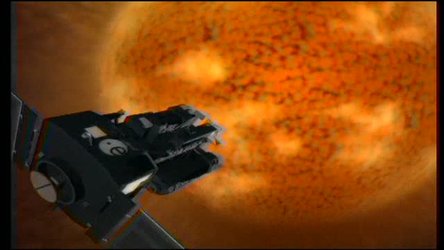Accept all cookies Accept only essential cookies See our Cookie Notice

About ESA
The European Space Agency (ESA) is Europe’s gateway to space. Its mission is to shape the development of Europe’s space capability and ensure that investment in space continues to deliver benefits to the citizens of Europe and the world.
Highlights
ESA - United space in Europe
This is ESA ESA facts Member States & Cooperating States Funding Director General Top management For Member State Delegations European vision European Space Policy ESA & EU Space Councils Responsibility & Sustainability Annual Report Calendar of meetings Corporate newsEstablishments & sites
ESA Headquarters ESA ESTEC ESA ESOC ESA ESRIN ESA EAC ESA ESAC Europe's Spaceport ESA ESEC ESA ECSAT Brussels Office Washington OfficeWorking with ESA
Business with ESA ESA Commercialisation Gateway Law at ESA Careers Cyber resilience at ESA IT at ESA Newsroom Partnerships Merchandising Licence Education Open Space Innovation Platform Integrity and Reporting Administrative Tribunal Health and SafetyMore about ESA
History ESA Historical Archives Exhibitions Publications Art & Culture ESA Merchandise Kids Diversity ESA Brand CentreLatest
Space in Member States
Find out more about space activities in our 23 Member States, and understand how ESA works together with their national agencies, institutions and organisations.
Science & Exploration
Exploring our Solar System and unlocking the secrets of the Universe
Go to topicAstronauts
Missions
Juice Euclid Webb Solar Orbiter BepiColombo Gaia ExoMars Cheops Exoplanet missions More missionsActivities
International Space Station Orion service module Gateway Concordia Caves & Pangaea BenefitsLatest
Space Safety
Protecting life and infrastructure on Earth and in orbit
Go to topicAsteroids
Asteroids and Planetary Defence Asteroid danger explained Flyeye telescope: asteroid detection Hera mission: asteroid deflection Near-Earth Object Coordination CentreSpace junk
About space debris Space debris by the numbers Space Environment Report In space refuelling, refurbishing and removingSafety from space
Clean Space ecodesign Zero Debris Technologies Space for Earth Supporting Sustainable DevelopmentLatest
Applications
Using space to benefit citizens and meet future challenges on Earth
Go to topicObserving the Earth
Observing the Earth Future EO Copernicus Meteorology Space for our climate Satellite missionsCommercialisation
ESA Commercialisation Gateway Open Space Innovation Platform Business Incubation ESA Space SolutionsLatest
Enabling & Support
Making space accessible and developing the technologies for the future
Go to topicBuilding missions
Space Engineering and Technology Test centre Laboratories Concurrent Design Facility Preparing for the future Shaping the Future Discovery and Preparation Advanced Concepts TeamSpace transportation
Space Transportation Ariane Vega Space Rider Future space transportation Boost! Europe's Spaceport Launches from Europe's Spaceport from 2012Latest

Soho discovers solar tornado
Thank you for liking
You have already liked this page, you can only like it once!
A gyrating high-speed storm wider than Africa projects from the south pole of the Sun, in the lower picture. It is one of a dozen such tornadoes found by the Soho solar spacecraft of ESA and NASA. The CDS scanning spectrometer made the discovery. It has imaged this previously unknown type of feature of the Sun's weather in gas at 250,000 degrees C. Measurements reveal flows of around 150 km/s. The colouring of the image shows, not the intensity of the emission, but the speed of the gas in the tornado. In the lighter right-hand side, the gas is moving away from Soho, and towards Soho the darker left-hand side. The speed measurements come from shifts in the apparent wavelength of an emission from charged oxygen atoms (Doppler effect). The immense size of the tornado is apparent from the comparison with the Earth on the same scale. Theorists now wonder what contribution the newly discovered tornadoes make to the solar wind that buffets the Earth's space environment and can harm satellites and power supplies. The upper picture, used to show the position of the tornado, was obtained on a different date by EIT, Soho's extreme ultraviolet imaging telescope. EIT keeps a daily watch on the Sun's weather at four different ultraviolet wavelengths. The emission that made this image came from gas at 80,000 degrees C, usually occurring fairly low in the Sun's atmosphere except in prominences. Here one prominence (bottom left) has erupted from the Sun. [Image Date: 1998/04] [98.04.017-003]
-
CREDIT
Tornado : Soho (ESA & NASA), CDS/RAL and C.D. Pike & H.E. Mason -
LICENCE
ESA Standard Licence

Science VNRs Apr/May 1998 Compil

Soho's Atlas-Centaur ready for launch

Soho preparation for thermal testing

Soho testing at Intespace















 Germany
Germany
 Austria
Austria
 Belgium
Belgium
 Denmark
Denmark
 Spain
Spain
 Estonia
Estonia
 Finland
Finland
 France
France
 Greece
Greece
 Hungary
Hungary
 Ireland
Ireland
 Italy
Italy
 Luxembourg
Luxembourg
 Norway
Norway
 The Netherlands
The Netherlands
 Poland
Poland
 Portugal
Portugal
 Czechia
Czechia
 Romania
Romania
 United Kingdom
United Kingdom
 Slovenia
Slovenia
 Sweden
Sweden
 Switzerland
Switzerland
























